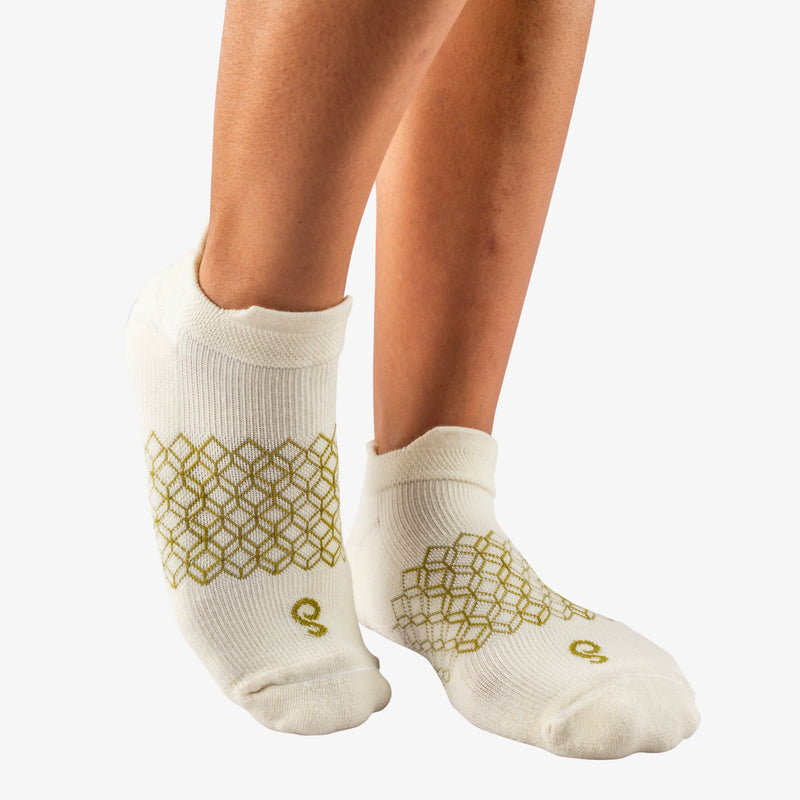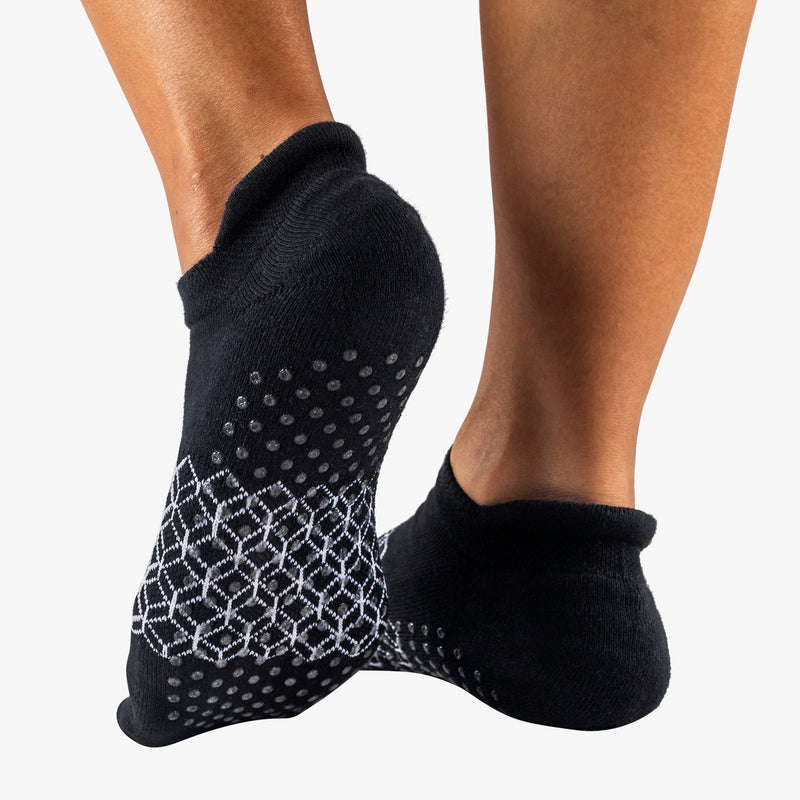
Pilates socks with cushioned soles are designed to enhance comfort and grip during workouts. These socks provide support that can improve stability and reduce the risk of slipping on mats or floors. Many practitioners find that the added cushioning helps them better connect with their movements, leading to a more effective session.
In addition to functionality, these socks come in various styles and materials, catering to personal preferences. The right pair can also add a touch of style to any workout outfit, making them a popular choice in the studio and at home. As individuals seek to optimise their Pilates experience, understanding the benefits of cushioned soles becomes essential.
Investing in quality Pilates socks can significantly impact performance and enjoyment. By focusing on comfort and safety, practitioners can fully engage in their routine and achieve the desired results.
Basics of Pilates Socks
Pilates socks serve a crucial role in enhancing performance and comfort during workouts. Special features like cushioned soles and specific materials contribute to the usability and effectiveness of these socks.
The Importance of Cushioned Soles in Pilates Socks
Cushioned soles provide essential support and comfort during Pilates exercises. They help to absorb impact, reducing strain on the feet and joints. This feature is particularly beneficial during high-intensity movements or extended sessions.
By using cushioned soles, practitioners can maintain better focus on their form rather than discomfort. Additionally, these soles often provide enhanced grip on various surfaces, promoting stability during balancing exercises.
Materials and Fabric Blends
The materials used in Pilates socks significantly affect their performance and durability. Common options include cotton, nylon, and spandex blends. Each fabric offers unique benefits:
- Cotton is breathable and comfortable, ideal for reducing moisture.
- Nylon contributes to durability and provides a snug fit.
- Spandex adds stretch, enabling freedom of movement.
Many Pilates socks incorporate moisture-wicking fabrics to keep feet dry. Some might also feature antimicrobial properties to minimise odour, enhancing overall sock hygiene.
Anatomy of Pilates Socks
Understanding the structure of Pilates socks can help consumers make informed choices. Key components include the cushioned sole, the moisture-wicking layer, and the grip features.
- Cushioned Sole: Provides comfort and support.
- Grip Dots: Often made from silicone, these are strategically placed to enhance traction.
- Arch Support: Some models include additional support in the arch area for improved foot stability.
These features combine to create a sock that not only meets the physical demands of Pilates but also enhances the overall workout experience.
Features of Cushioned Sole Pilates Socks
Cushioned sole Pilates socks offer a range of features that enhance comfort, stability, and performance during workouts. These socks are designed specifically to support the foot while providing adequate grip, allowing for better movement control.
Cushioning Distribution
Cushioned soles have strategically placed padding that absorbs impact, reducing strain on the feet and joints. This padding typically extends across the ball of the foot and the heel, which are the primary areas that experience pressure during exercises.
The level of cushioning can vary. Some socks offer thick cushioning for maximum comfort, while others provide a more minimalist approach, keeping the foot close to the ground for better proprioception.
This thoughtful design helps to maintain foot health, particularly during high-repetition movements often found in Pilates.
Arch Support
Arch support in cushioned sole Pilates socks is essential for maintaining proper alignment and reducing fatigue. This feature often includes a reinforced design that cradles the arch, which can enhance balance and stability during various exercises.
With adequate arch support, the foot is less likely to overpronate. This is crucial for those with flat feet or high arches, as it can help prevent injuries.
The combination of cushioning and arch support contributes to optimal performance in Pilates classes, allowing for smoother transitions between movements.
Grip Patterns
Effective grip patterns on the soles of Pilates socks are vital for maintaining traction on slippery surfaces. These patterns often consist of silicone dots or textured rubber that enhance grip without compromising flexibility.
Different brands offer unique gripping solutions, but all aim to provide a non-slip experience during dynamic movements. High-quality grip can prevent slipping, allowing individuals to focus on their form rather than their footing.
Furthermore, these patterns do not add bulk, preserving the sock's streamlined profile while enhancing functionality.
Advantages of Wearing Pilates Socks with Cushioned Soles
Wearing Pilates socks with cushioned soles provides several benefits that enhance the overall experience during workouts. These advantages include increased comfort, reduced risk of injury, improved performance, and better balance and stability.
Enhanced Comfort
Cushioned soles in Pilates socks significantly contribute to comfort during exercise. The extra padding allows for better protection against discomfort from hard surfaces. This feature is particularly beneficial in a Pilates class where movements require lying or kneeling on mats.
The cushioning absorbs pressure, reducing fatigue in the feet and legs. It permits longer sessions without discomfort, keeping the practitioner focused solely on their movements. Soft, breathable materials in these socks also enhance airflow, preventing overheating during intense workouts.
Reduced Impact and Injury Risk
Cushioned soles play a crucial role in minimising impact during exercises. This added layer of protection can help absorb shock during jumps or other high-impact positions, which is vital for maintaining joint health.
Injuries often stem from repetitive stress, and wearing these socks can reduce strain on the feet and ankles. By distributing weight evenly, cushioned soles lower the risk of developing conditions like plantar fasciitis or shin splints. This can be particularly advantageous for beginners or those returning to exercise.
Improved Performance
Pilates practitioners often seek to improve their range of motion and control. The added cushioning in these socks can enhance proprioception. This allows for better awareness of foot placement and alignment during workouts.
Enhanced grip from specialised non-slip materials in cushioned socks further supports a solid base. This can lead to improved form in various exercises. Better form can result in more effective workouts and increased strength over time.
Balance and Stability
Cushioned soles contribute significantly to balance and stability on various surfaces. The extra padding enhances contact with the ground, which helps practitioners feel more secure during poses or transitions.
With improved grip, these socks prevent slipping, particularly on smooth surfaces. This stability is essential for executing complex movements accurately. Practitioners may find themselves more confident in their ability to perform challenging moves, leading to overall improvements in their Pilates practice.
Selecting the Right Pilates Socks
Choosing the right Pilates socks is essential for optimal performance and comfort. Key aspects include ensuring the proper size and fit, selecting the appropriate sole thickness, and prioritising breathability and moisture-wicking capabilities.
Size and Fit
The size and fit of Pilates socks significantly affect their performance. They should fit snugly without feeling cramped. A tight fit ensures better grip, reducing the risk of slipping during workouts.
Different brands may offer varying sizes, so checking sizing charts is advisable. Look for socks that feature stretchy materials, as these can accommodate a range of foot shapes. A well-fitting sock should also maintain its position without sliding down.
Those who prefer toe socks should consider how each toe fits within the designated sections, ensuring comfort and functionality.
Sole Thickness
Sole thickness is another critical factor in selecting Pilates socks. Thicker soles provide more cushioning, which can enhance comfort during exercises that require balance or stability. This feature helps reduce impact on the feet, particularly during high-intensity workouts.
Conversely, thinner soles offer better ground feel, allowing for more proprioception. This can be beneficial when performing intricate movements that require precision.
Ultimately, the choice between thick or thin soles will depend on personal preference and the type of Pilates practice being undertaken. Some may prefer a balance of both, opting for socks that feature varying thicknesses for different activities.
Breathability and Moisture Wicking
Breathability and moisture-wicking properties are vital for maintaining comfort during workouts. Pilates socks made from materials such as cotton blends or synthetic fabrics can help keep feet dry and comfortable.
Moisture-wicking designs actively pull sweat away from the skin, reducing the feeling of dampness. This is especially important during longer sessions or in warmer environments.
Additionally, breathable fabrics assist in temperature regulation, preventing overheating. Opting for socks with ventilation zones or mesh panels can further enhance airflow. Prioritising these features will contribute to a more enjoyable and effective Pilates experience.
Care and Maintenance
Proper care and maintenance of Pilates socks with cushioned soles will extend their lifespan and ensure optimal performance. Following specific washing instructions and knowing when to replace them can keep these accessories in top condition.
Washing Instructions
To maintain the integrity of Pilates socks, it is crucial to follow proper washing instructions. It is recommended to wash them in cold water to prevent shrinkage and fading. Use a gentle cycle to protect the fabric and cushioning.
Avoid fabric softeners, as they can reduce grip effectiveness. It is best to air dry the socks rather than using a tumble dryer, as heat can weaken elastic materials. Resolve stains promptly with mild detergent rather than harsh chemicals to preserve colour and texture.
Durability: Care Tips
Caring for Pilates socks can significantly impact their durability. Store them in a cool, dry place away from direct sunlight, which can degrade the material. Regularly inspect the socks for signs of wear, such as thinning areas or loss of elasticity.
Avoid using them on rough surfaces to prevent premature damage. Rotating between multiple pairs can also reduce wear and tear, allowing each pair to rest between uses. Keeping toenails trimmed can prevent snagging or tearing in the fabric, thus enhancing longevity.
When to Replace Your Pilates Socks
Timing is essential for replacing Pilates socks to maintain safety and comfort. Signs of wear include noticeable thinning on the soles or loss of grip, which can increase the risk of slipping.
If the cushioning feels flat and does not provide adequate support, it is time for a new pair. Generally, Pilates socks should be replaced every 6 to 12 months, depending on usage frequency and personal preference. Regularly assessing their condition can prevent injuries during practice.
Styles and Aesthetics
Pilates socks with cushioned soles come in a variety of styles and aesthetic choices. From colour to patterns, these elements enhance both functionality and personal expression during practice.
Colour Variations
Colour plays a significant role in the appeal of Pilates socks. They are available in a spectrum that ranges from muted tones to vibrant hues. Users can select shades that match their workout attire or personal style, allowing for a cohesive look.
Popular colours include classic black and grey, which offer versatility. In contrast, brighter options such as teal, fuchsia, or lime green can add a pop of colour to any outfit. Customisation is also common, with brands offering specialised colour collections for seasonal trends.
Pattern Trends
Patterned socks can elevate the aesthetic experience of Pilates. They often feature designs such as stripes, polka dots, or geometric shapes. These patterns add visual interest while catering to various tastes.
Some brands collaborate with designers to create limited-edition patterns, making the socks more appealing to fashion-conscious practitioners. Neutral patterns can subtly complement an outfit, while bold designs can serve as the focal point of the ensemble.
Branding and Visual Appeal
Branding influences the visual appeal of Pilates socks significantly. Many companies emphasise their logos and designs prominently, which can enhance brand recognition. Desirable brands often incorporate unique colour schemes and patterns that reflect their identity.
Additionally, quality and comfort are integral to branding. Companies that highlight innovative materials and ergonomic design gain a reputation among consumers. This approach not only promotes brand loyalty but also assures users of their investment in both style and performance.
Environmental Considerations
The sustainability and environmental impact of Pilates socks with cushioned soles are significant factors for environmentally conscious consumers. This section explores the materials used and the production practices employed in their manufacture.
Eco-Friendly Materials
Many Pilates socks are made from eco-friendly materials that minimise environmental impact. For instance, organic cotton is commonly used due to its reduced chemical input compared to conventional cotton.
Bamboo is another popular option. It grows quickly and requires less water. Additionally, bamboo has natural antibacterial properties, which can help with hygiene.
Recycled materials, such as recycled polyester, are also emerging in this market. This helps reduce waste by repurposing plastic bottles and similar products. Consumers should look for certifications that indicate a material's eco-friendliness for assurance.
Sustainability in Production
Sustainable production practices are increasingly important in the textile industry, including for Pilates socks. Brands are now prioritising ethical manufacturing processes that aim to reduce carbon footprints.
Some companies are implementing energy-efficient machinery and reducing water usage during production. Using dyes that are free from harmful chemicals is another step towards sustainability.
Additionally, many manufacturers are adopting fair labour practices, ensuring that workers are treated ethically. By choosing brands that commit to sustainable practices, consumers can support a more responsible industry.
Purchasing Options
When considering pilates socks with cushioned soles, it's important to evaluate where to buy them, potential price ranges, and various brands available in the market. Each of these aspects can significantly influence the buying decision.
In-Store vs Online Shopping
Shopping in-store provides a tactile experience that cannot be replicated online. Customers can try on different brands and styles, ensuring the fit and comfort meet their expectations. Many stores also offer specialised staff who can provide guidance on features and benefits.
Conversely, online shopping offers a wider selection and often better prices. Customers can easily compare multiple brands and read reviews. Websites usually provide detailed sizing charts, which can help in selecting the right fit.
Each shopping method has its benefits, so understanding personal preferences is key to making the right choice.
Price Points
Pricing for pilates socks with cushioned soles can vary significantly based on brand, materials, and additional features. Generally, prices range from £10 to £30 per pair.
Budget-friendly options may offer basic cushioning and style, while premium brands often enhance comfort and durability with advanced materials. Customers should assess their usage frequency and budget when considering their purchase.
Finding value for money is essential. Higher-priced socks might last longer and provide better performance, especially for frequent practitioners.
Brand Comparisons
Several brands stand out in the market for pilates socks. Each offers distinct qualities and price ranges. Brands like ToeSox and Liforme are often praised for their grip and comfort. They usually utilise high-quality materials, ensuring long-lasting use.
More affordable brands, like Gaiam and Amazon Essentials, provide basic options suitable for beginners. They may lack some enhancements found in premium brands but still deliver satisfactory performance.
Conducting thorough research on brand reviews and product specifications helps customers make informed choices about which pilates socks to purchase.
Frequently Asked Questions
This section addresses common queries regarding Pilates socks with cushioned soles. It focuses on features, materials, benefits, and specific considerations for practitioners.
What features should I consider when purchasing Pilates socks?
When selecting Pilates socks, consider grip, cushioning, and breathability. A non-slip sole is essential for stability during exercises. Additionally, look for a snug fit that allows for freedom of movement.
How do the materials of Pilates socks affect their performance?
The materials influence durability, moisture-wicking capabilities, and overall comfort. Cotton blends may provide breathability, while synthetic materials can enhance grip and elasticity. Each option offers different benefits based on personal preferences and exercise intensity.
Why might Pilates practitioners choose socks with cushioned soles?
Cushioned soles offer added comfort and support during workouts. They can absorb impact and reduce strain on joints, which is beneficial for those engaging in high-repetition movements. Practitioners may find this padding enhances their overall experience.
Are there specific benefits to wearing men’s Pilates socks during a session?
Men’s Pilates socks are designed with wider fits and different styles to accommodate male foot shape. They may offer similar cushioning and grip but cater specifically to the male anatomy. This ensures optimal performance and comfort.
What distinguishes reformer Pilates socks from regular Pilates socks?
Reformer Pilates socks typically feature extra grip on the soles to prevent slipping on equipment. They may also have ankle support or specific designs suited for reformer machines. This helps enhance stability during dynamic movements.
How can one ensure the longevity of their Pilates grip socks?
To maintain Pilates grip socks, wash them in cold water and avoid fabric softeners. Air drying is recommended to prevent degradation of materials. Storing them in a cool, dry place can also extend their lifespan.













